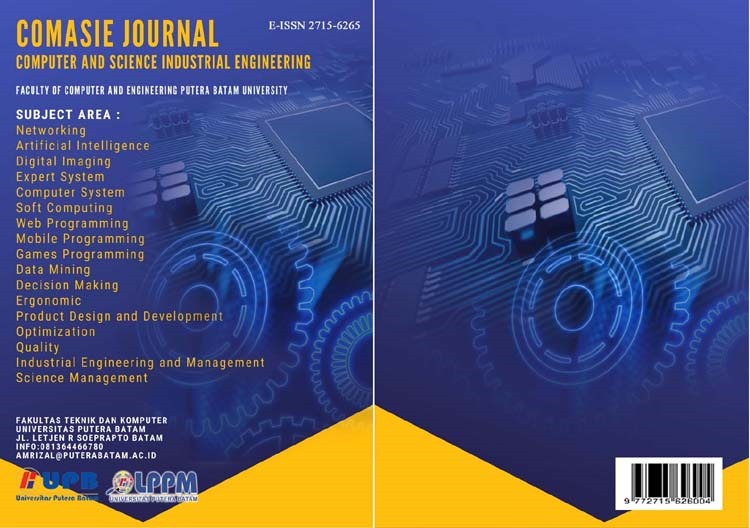IMPLEMENTASI DEEP LEARNING DALAM SISTEM ABSENSI SISWA DENGAN FACE RECOGNITION
DOI:
https://doi.org/10.33884/comasiejournal.v11i3.9103Kata Kunci:
Attendance System; Artificial Intelligence; Convolutional Neural Network (CNN); Deep Learning; Face Recognition.Abstrak
In an era where information technology is pervasive, education is impacted significantly. One technology being adopted is face recognition for student attendance authentication, which is more resistant to forgery and manipulation than methods like RFID cards. It offers high accuracy and can function under various conditions, making it effective and efficient. Student attendance is crucial for the effectiveness of the learning process. Traditional methods have limitations in accuracy, speed, and convenience. Institutions have shifted to technology-based methods such as mobile applications or RFID devices, which still require physical interaction. Face recognition, with deep learning, promises to streamline the attendance process by enhancing accuracy and efficiency. Deep learning processes complex data, such as facial images, with high accuracy. Integrating face recognition with deep learning can address challenges like pose variation, facial expressions, and lighting conditions. The objectives of this research aim to make a substantial contribution to the current development of student attendance technology, improving administrative processes in educational institutions.
Referensi
Abbas, Z. K., & Al-Ani, A. A. (2023). An adaptive algorithm based on principal component analysis-deep learning for anomalous events detection. Indonesian Journal of Electrical Engineering and Computer Science, 29(1), 421–430. https://doi.org/10.11591/ijeecs.v29.i1.pp421-430
ElWahab, Y. S. A., Nasr, M. M., & Al Sheref, F. K. (2023). An intelligent oil accident predicting and classifying system using deep learning techniques. Indonesian Journal of Electrical Engineering and Computer Science, 29(1), 460–471. https://doi.org/10.11591/ijeecs.v29.i1.pp460-471
Saragih, S. P. (2018). Implementasi Platform Media Sosial Sebagai Business Support oleh Pelaku Usaha Wisata di Kota Batam. Journal of Applied Informatics and Computing, 2(2), 15–23. https://doi.org/10.30871/jaic.v2i2.1016
Faris Abdlkader, D., & Faris Ghanim, M. (2024). Design and analysis of face recognition system based on VGGFace-16 with various classifiers. IAES International Journal of Artificial Intelligence (IJ-AI), 13(2), 1499. https://doi.org/10.11591/ijai.v13.i2.pp1499-1510
Idrissi, I., Boukabous, M., Azizi, M., Moussaoui, O., & Fadili, H. El. (2021). Toward a deep learning-based intrusion detection system for iot against botnet attacks. IAES International Journal of Artificial Intelligence, 10(1), 110–120. https://doi.org/10.11591/ijai.v10.i1.pp110-120
Jadhav, A., Kamble, D., Rathod, S. B., Kumar, S., Kadam, P., & Dalwai, M. (2024). Attendance management system using face recognition. IAES International Journal of Artificial Intelligence, 13(1), 673–679. https://doi.org/10.11591/ijai.v13.i1.pp673-679
Medjahed, C., Rahmoun, A., Charrier, C., & Mezzoudj, F. (2022). A deep learning-based multimodal biometric system using score fusion. IAES International Journal of Artificial Intelligence, 11(1), 65–80. https://doi.org/10.11591/ijai.v11.i1.pp65-80
Shrestha, A., & Mahmood, A. (2019). Review of deep learning algorithms and architectures. In IEEE Access (Vol. 7, pp. 53040–53065). Institute of Electrical and Electronics Engineers Inc. https://doi.org/10.1109/ACCESS.2019.2912200
Tangwannawit, S., & Tangwannawit, P. (2022). An optimization clustering and classification based on artificial intelligence approach for internet of things in agriculture. IAES International Journal of Artificial Intelligence, 11(1), 201–209. https://doi.org/10.11591/ijai.v11.i1.pp201-209
Yajie, L., Johar, M. G. M., & Hajamydeen, A. I. (2023). Poultry disease early detection methods using deep learning technology. Indonesian Journal of Electrical Engineering and Computer Science, 32(3), 1712–1723. https://doi.org/10.11591/IJEECS.V32.I3.PP1712-1723
Saragih, S. P., Gaol, I. L. S. L., Sihotang, S. J., & Banjarnahor, T. (2018). Optimasi Aplikasi Media Sosial dan Digital Content Editing untuk Mendukung Promosi Wisata Digital kepada Masyarakat Pulau Setokok. J-ABDIPAMAS (Jurnal Pengabdian Kepada Masyarakat), 2(2), 101. https://doi.org/10.30734/j-abdipamas.v2i2.284
Zaman, T. U., Alharbi, E. K., Bawazeer, A. S., Algethami, G. A., Almehmadi, L. A., Alshareef, T. M., Alotaibi, Y. A., & Karar, H. M. O. (2023). Artificial intelligence: the major role it played in the management of healthcare during COVID-19 pandemic. IAES International Journal of Artificial Intelligence, 12(2), 505–513. https://doi.org/10.11591/ijai.v12.i2.pp505-513














